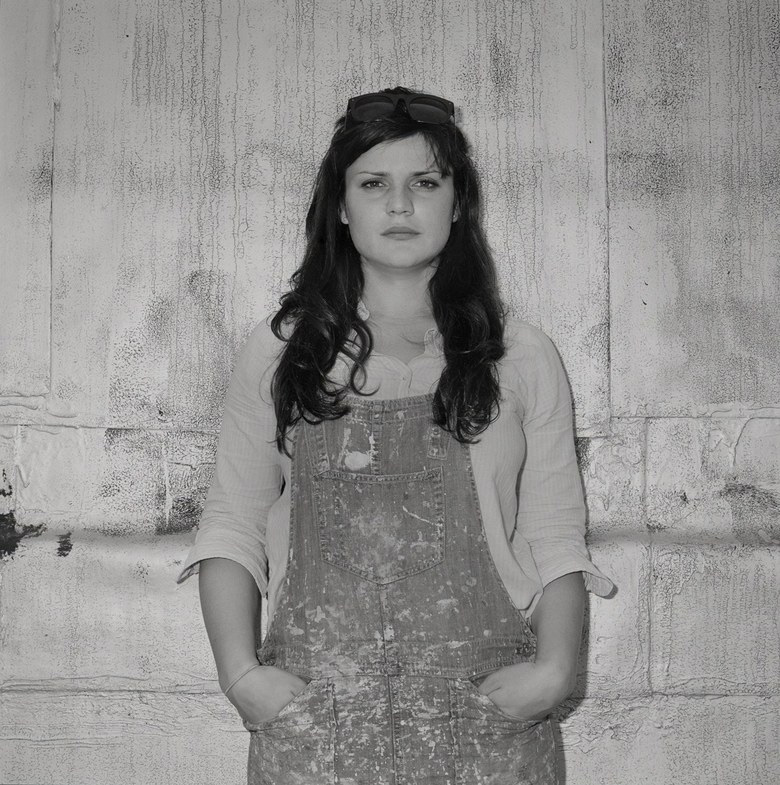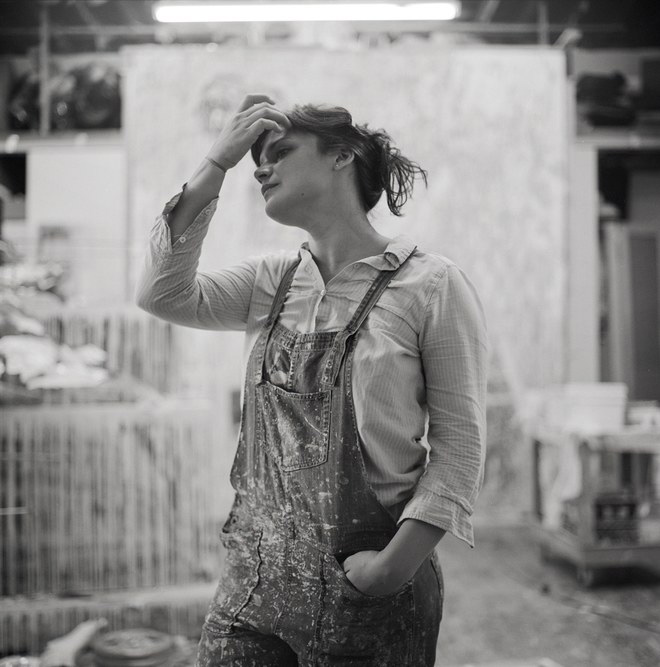
- Source: VOGUE
- Author: THESSALY LA FORCE
- Date: SEPTEMBER 10, 2014
- Format: DIGITAL
ARTIST DIANA AL-HADID ON FATE, FORM, AND FREUD—AND HER NEW EXHIBITION AT THE SECESSION IN VIENNA

Photographed by Mark Peckmezian
“Maybe you can help me out,” Diana Al-Hadid says to me with a soft smile on her face. She’s standing in the single air-conditioned room of her East Williamsburg studio in front of a desktop computer. It’s late summer, and final decisions must be made for her upcoming exhibition at the Secession in Vienna, Austria. Namely, she needs to decide on a title. “There is a danger to titles,” she notes with a tilt of her head. “There is something nice about them, but it can be another mark on the piece.” She also needs to decide which of her early sketches should be included in the catalogue. Over the past few weeks, a large installation she created for the exhibition—consisting of a large interlocking arrangement of sculptures and additional panels—has been shipped off to Europe, and in the heat of the summer, you can feel the negative space that its departure has created throughout the studio. The opening date, September 11, feels awfully close, but Al-Hadid is very calm about all the loose ends and unanswered questions.
That might be her point. Al-Hadid, who is 33 years old, has been working on the installation for the last two years, between creating other works of art at a prolific pace. With the Vienna installation in particular, she wanted to take her time, to let the idea come to her without knowing exactly where she was going or what she was doing. “I really didn’t set up to understand it,” she explains. “I didn’t have anything to understand. I wanted to start from scratch—it was really raw. I was interested in what you gravitate towards without being too conscious of it.” As she explains its various components (using materials such as gold leaf, steel, wood, plaster, and fiberglass), it’s impressive to hear how much she trusts her peripheral vision as an artist—how she lets certain narratives or references speak to her, slowly, and allow their importance to bubble up through her subconscious.
“We started with this figure,” Al-Hadid says, pointing to the bust in the center of the piece. “She was this woman I had laying around—she was almost decomposing in the studio.” Al-Hadid is referring to the cast of a mold for a sculpture called Antonym that she showed two years ago at the Marianne Boesky Gallery in New York. She kept the cast, and over time, as it began to acquire a Duchamp-like patina from plaster fillings and studio dust, the form began to haunt her imagination. “I had this residual person in my studio, which is kind of gross, but her surfaces looked a lot like my drawings,” she says. “It was decomposing and rotting, but it was also kind of beautiful because I had worked on it so much.” Al-Hadid set the figure floating on a pedestal and became fixated with creating several layers and playing with opacity, eventually filling in the space around her with what she called “razor-thin puddles”—even leaving a discombobulated leg trailing off behind the bust.
The female form is referenced more subtly in a separate panel of the installation—and it reveals a bit more of the gears turning inside Al-Hadid’s mind. The form in question belongs to Gradiva, a fictional figure, here deconstructed, sliced into four parts, like a “stutter,” according to Al-Hadid. The character of Gradiva (the “woman who walks”) originally appeared in a 1903 novella by the German writer Wilhelm Jensen, but was popularized by Sigmund Freud four years later, in a 1907 essay about dreams and delusions. The story goes something like this: A young archaeologist discovers a Roman bas-relief of a beautiful woman walking. He falls completely under her spell. Writes Jensen: “He could not explain what quality in it had aroused his attention; he knew only that he had been attracted by something, and this effect of the first view had remained unchanged since then.” It “attracts him so exceptionally,” Freud writes in his subsequent summary of the novella, “that he is delighted to be able to get an excellent plaster-cast of it which he can hang up in his study in a German university-city, and study with interest.” Soon, the archaeologist begins to see Gradiva everywhere—he thinks he recognizes her feminine gait in a woman walking down the street. He has a vivid dream that he encounters her in the ancient city of Pompeii. Later, we learn that the archaeologist’s obsession with Gradiva is rooted in a repressed memory of a childhood love. “Freud thought of this as a metaphor for the psychoanalytic process,” adds Al-Hadid.
When asked if Al-Hadid’s fascination with Gradiva might explain on some subconscious level her attraction to using the cast from Antonym, the artist beams. Jensen’s novella illustrates how obsession can manifest itself subconsciously by an attraction to a particular form, repeated over and over in different settings and states—just in the way the archaeologist believes he sees Gradiva wherever he goes, both in the flesh and in rubble, in present day and also in the past. “She is a little bit of a double,” Al-Hadid says. “She’s the same as Gradiva—that’s good, good. She’s the castoff—I didn’t excavate that from my mind.” She laughs. “I didn’t think, ‘She’s the first one, she’s the one that made the mold. She’s the original.’ Funny!”
Al-Hadid loves to reference art from centuries past, and she shares another one of her starting points for the installation: a well-known oil-on-wood painting called Allegory of Chastity, by Hans Memling, which depicts a woman piously standing in the center of an imposing mountain. Al-Hadid used the image to create one of the panels. “It’s the weirdest painting ever, maybe not the weirdest ever, but she is emerging from a mountain,” Al-Hadid says, shaking her head in wonder. “She is cut and pasted, grafted onto this mountain, like it’s her body part—I mean, to have a mountain as gaping hole. . . ”
Asked why she’s drawn toward artwork from centuries past,she pauses, searching for an answer that never comes. Later, when I ask her what led her to become an artist in the first place, her assistant enters the room and, overhearing us, insists that Al-Hadid show me her juvenilia. Al-Hadid opens another file on the computer, unveiling early sketches and drawings she made when she was in high school, well after she immigrated to the United States from Syria, where she was born. One is a remarkably precise rendering of a little girl with a ponytail, her head resting on her chin, glasses slipping down the bridge of her nose. Al-Hadid lets out a hearty laugh and recalls the inspiration: She was copying an advertisement. “My big creative moment was getting rid of the Crayola marker she’s holding in her left hand,” she says. I remark on how painstakingly detailed it appears. “I was trying to be a Northern Renaissance painter,” she says, after a pause. “I was trying to be van Eyck. I never thought about that. Maybe that’s the attraction.”
Everything in Al-Hadid’s approach feels unencumbered by pretense or an overbearing sense of purpose. What comes to her as an artist simply becomes part of the work; her need to explain the idea is less necessary than expressing it. Later, when I write to ask her if she’s decided upon a title, she responds that she has. She has decided to call it “The Fates.”


